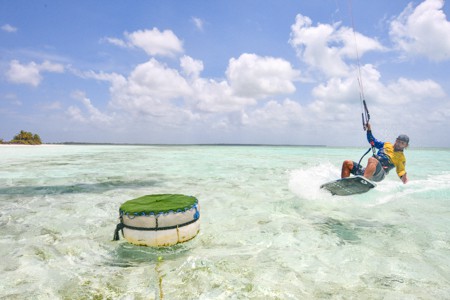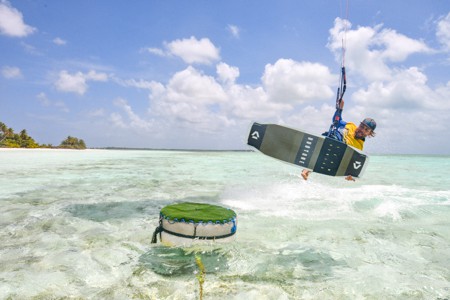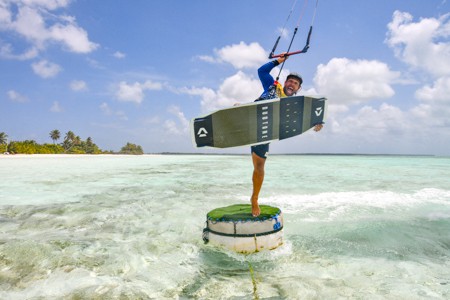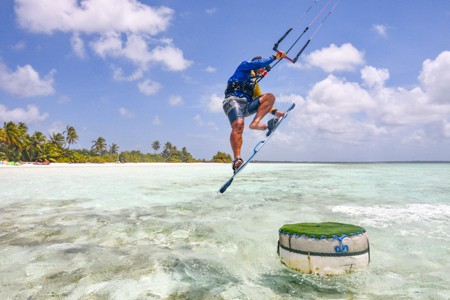Kitesurf tricks with the Stoke Coach on location in Cocos Islands
This is one of my favourite tricks for two reasons, firstly I love one footer’s as I think they are super stylish. Secondly they look quite technical, but in reality, they are quite simple and very achievable for even an average kitesurfer.
To add a one-footer into a transition or jump can look really cool, and with a bit of practice you can lock it in and even add rotations.
A foot plant is a jump or transition that incorporates a one foot manoeuvre, to achieve this you grab the end of your board and take out one of your feet from footstraps, I will try to tweak this with a straight leg and tweak of the board and often throw in a rotation, which I think helps me land the transitions easier.
The foot plant is all about timing. If you get everything lined up there’s a good chance you’ll get a nice stationary float to enable you to pop out your foot and plant that down on the beach or the water.
I’m going to talk you through how I like to do the manoeuvre, highlighting elements you really need to focus on and the common mistakes that are made when attempting this trick.
My preferred direction is going left and I like to throw in a back roll rotation which helps me spot my landing. It feels natural to rotate throughout the transition allowing a nice flow throughout the manoeuvre.
Before attempting this trick I would practice jumping to your right and taking out your left foot as you’ll be removing your foot the same way. Also, make sure you have your back roll transitions down and making them as floaty as possible.
Coming into the manoeuvre it’s all about timing.
You are trying to transfer as much of your forward momentum as possible, transferring that energy into your upwind carve and loading up the kite.
Key points:
- The carve wants to be strong and steady, finishing with the nose of the board pointing as straight into the wind as you can.
- Your kite should be at 12 o’clock (or even just passed) it as you reach the end of the carve. This timing is crucial in delivering the vertical lift and the float you need.
Top tip – after sending the kite to 12 o’clock, watch the kite and time your carve upwind accordingly. Waiting till 11 or even 11:30 before initiating the carve up wind.

While I’m carving upwind and loading up the kite my bar is often out halfway or even further.
As I pop off the water I can control my height and float by sheeting in the bar more or less throughout the whole manoeuvre. This control over how high I go makes sure I’m the right height for the foot plant.
As I finish the carve and pop off the water I’m almost halfway around the rotation; which is why I like to throw in the back roIl.
As I leave the water, I sheet in the bar a little to give me float while I reach for the front nose of my board. Bend the front knee and leave the back leg as straight as you can to help bring the nose to you, rather than reaching over.

Once you have the grab take out the front foot and plant it down on the water or whatever you’re jumping over.
Top tip – You can tweak the maneuver by straightening the front leg as you push off whatever you’re jumping over, also as you’ve got the grab so tweak the board, lift it up in front of you with a straight arm.

As soon as you get the foot plant it’s time to spot your landing.
Pull hard with your right hand to initiate the dive of the kite, back in the direction you came from. Hold the grab as you put your foot back into the footstrap and point the board in the direction the kites pulling you.
You want to land flat on the board, pointing downwind and not on your edge.
Top tip – get your body position and back foot in the right spot for the landing and bring the board to your foot. If you’re running out of time you can ride out even if you don’t get back in your strap, placing your foot on the board where you can.

Depending on the wind power or how clean you land the trick, you may finish with a Kite loop. I’ll rarely loop the Kite while I’m still in the air but will often turn the dive of the Kite into a Kite loop after landing, this can give me the speed and power I need to ride out, or shuffle and move my feet back into the strap.
Common mistakes.
Too much speed:
If you come into the transition without reducing your forward momentum you’ll travel horizontal to much, it makes it harder to land, and you’ll often have no power when you dive the Kite!
Focus on the Kite being at 12 as you carve upwind:
Timing is critical as you want a vertical jump minimising the distance you travel forward.
Missing your foot plant:
Even if you planting your foot on the water, make sure you pick the exact spot! You want to Finnish you carve a meter or so in front of it! This will also help you shave off your forward momentum.
The one-foot plant is a great trick to practice and learn, and is pretty forgiving if you crash and burn! And remember…
Have fun out there, keep it simple and make it stylish!

The Stoke Coach Ben Strowger is a team rider for Duotone Kiteboarding & Zephyr Tours, manager and kite instructor for Ocean Addicts.
